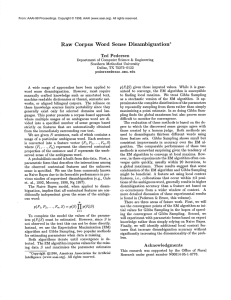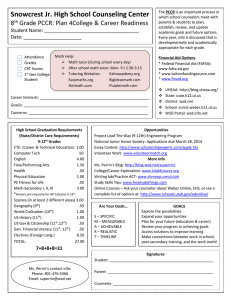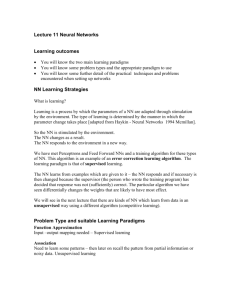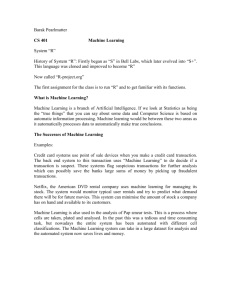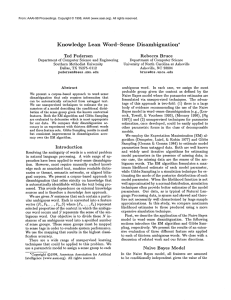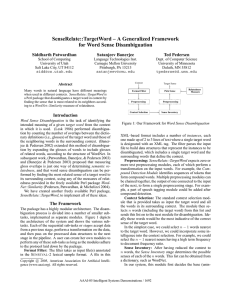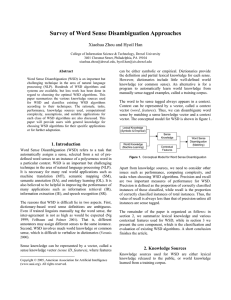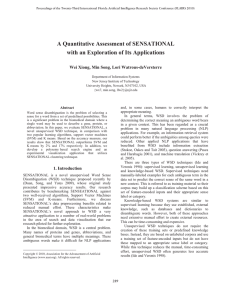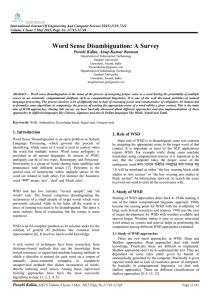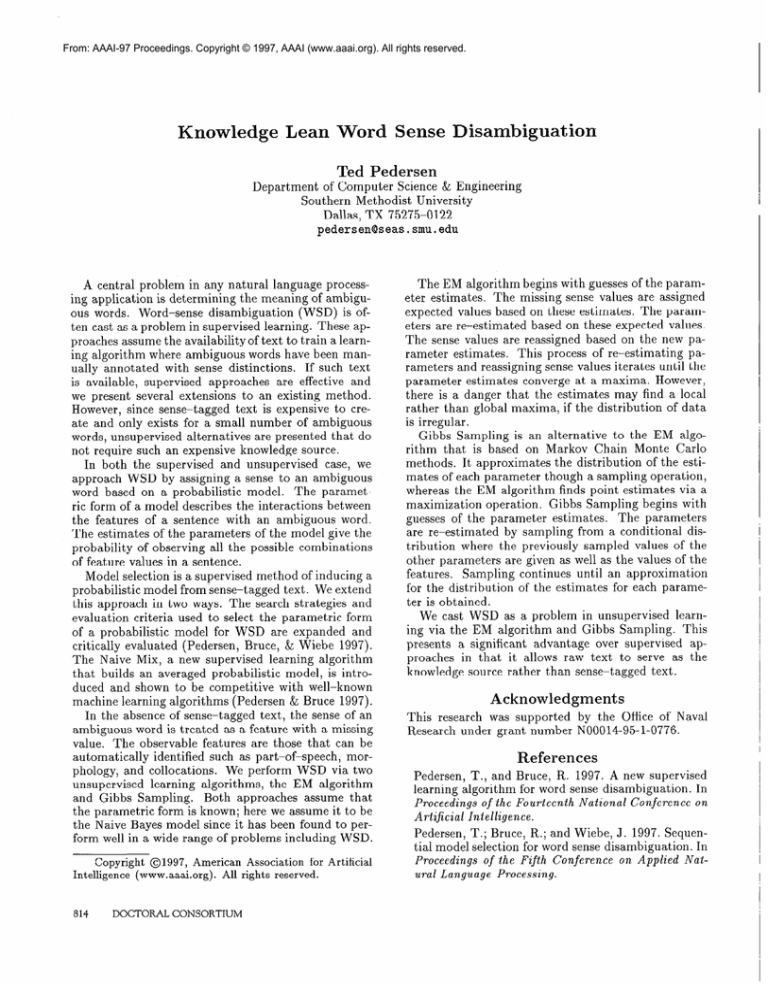
From: AAAI-97 Proceedings. Copyright © 1997, AAAI (www.aaai.org). All rights reserved.
Knowledge
Lean Word
Sense Disambiguation
Ted Pedersen
Department
of Computer Science & Engineering
Southern Methodist University
Dallas, TX 75275-0122
pedersen@seas.smu.edu
A central problem in any natural language processing application is determining the meaning of ambiguous words. Word-sense
disambiguation
(WSD) is often cast as a problem in supervised learning. These approaches assume the availability of text to train a learning algorithm where ambiguous words have been manually annotated
with sense distinctions.
If such text
is available, supervised approaches
are effective and
we present several extensions
to an existing method.
However, since sense-tagged
text is expensive to create and only exists for a small number of ambiguous
words, unsupervised alternatives are presented that do
not require such an expensive knowledge source.
In both the supervised and unsupervised
case, we
approach WSD by assigning a sense to an ambiguous
word based on a probabilistic
model.
The parametric form of a model describes the interactions
between
the features of a sentence with an ambiguous word.
The estimates of the parameters of the model give the
probability
of observing all the possible combinations
of feature values in a sentence.
Model selection is a supervised method of inducing a
probabilistic model from sense-tagged
text. We extend
this approach in two ways. The search strategies and
evaluation criteria used to select the parametric form
of a probabilistic
model for WSD are expanded and
critically evaluated (Pedersen, Bruce, & Wiebe 1997).
The Naive Mix, a new supervised learning algorithm
that builds an averaged probabilistic
model, is introduced and shown to be competitive
with well-known
machine learning algorithms (Pedersen & Bruce 1997).
In the absence of sense-tagged
text, the sense of an
ambiguous word is treated as a feature with a missing
value. The observable features are those that can be
automatically
identified such as part-of-speech,
morphology, and collocations.
We perform WSD via two
unsupervised
learning algorithms,
the EM algorithm
and Gibbs Sampling.
Both approaches
assume that
the parametric form is known; here we assume it to be
the Naive Bayes model since it has been found to perform well in a wide range of problems including WSD.
Copyright 01997, American Association for Artificial
Intelligence (www.aaai.org). AII rights reserved.
814
DOCTORAL CONSORTIUM
The EM algorithm begins with guesses of the parameter estimates.
The missing sense values are assigned
expected values based on these estimates.
The parameters are re-estimated
based on these expected values.
The sense values are reassigned based on the new parameter estimates.
This process of re-estimating
parameters and reassigning sense values iterates until the
parameter estimates converge at a maxima. However,
there is a danger that the estimates may find a local
rather than global maxima, if the distribution
of data
is irregular.
Gibbs Sampling is an alternative
to the EM algorithm that is based on Markov Chain Monte Carlo
methods.
It approximates
the distribution
of the estimates of each parameter though a sampling operation,
whereas the EM algorithm finds point estimates via a
maximization
operation.
Gibbs Sampling begins with
guesses of the parameter
estimates.
The parameters
are re-estimated
by sampling from a conditional
distribution where the previously sampled values of the
other parameters are given as well as the values of the
features.
Sampling continues until an approximation
for the distribution
of the estimates for each parameter is obtained.
We cast WSD as a problem in unsupervised
learning via the EM algorithm and Gibbs Sampling.
This
presents a significant
advantage over supervised
approaches in that it allows raw text to serve as the
knowledge source rather than sense-tagged
text.
Acknowledgments
This research was supported
Research under grant number
by the Office of Naval
N00014-95-1-0776.
References
Pedersen, T., and Bruce, R. 1997. A new supervised
learning algorithm for word sense disambiguation.
In
Proceedings of the Fourteenth National Conference
on
Artificial Intelligence.
Pedersen, T.; Bruce, R.; and Wiebe, J. 1997. Sequential model selection for word sense disambiguation.
In
Proceedings of the Fifth Conference
on Applied Natural Language Processing.

